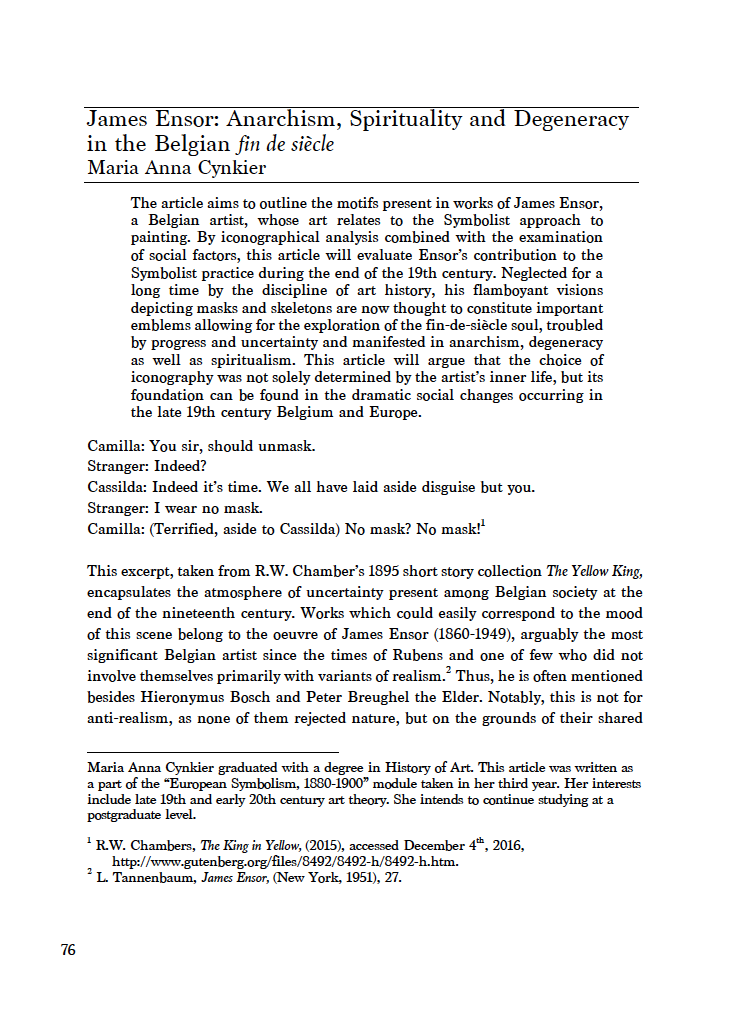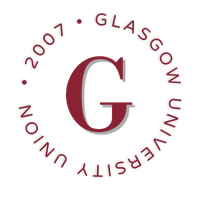James Ensor
Anarchism, Spirituality and Degeneracy in the Belgian fin de siècle
DOI:
https://doi.org/10.36399/GroundingsUG.10.189Keywords:
James Ensor, Symbolism, Belgian Art, Iconography, Fin-de-siècleAbstract
The article aims to outline the motifs present in works of James Ensor, a Belgian artist, whose art relates to the Symbolist approach to painting. By iconographical analysis combined with the examination of social factors, this article will evaluate Ensor’s contribution to the Symbolist practice during the end of the 19th century. Neglected for a long time by the discipline of art history, his flamboyant visions depicting masks and skeletons are now thought to constitute important emblems allowing for the exploration of the fin-de-siècle soul, troubled by progress and uncertainty and manifested in anarchism, degeneracy as well as spiritualism. This article will argue that the choice of iconography was not solely determined by the artist’s inner life, but its foundation can be found in the dramatic social changes occurring in the late 19th century Belgium and Europe.
References
A. Swinbourne (ed.), James Ensor, (New York, 2009)
B. Larson, ‘Evolution and Degeneration in the Early Work of Odilon Redon’, Nineteenth Century Art Worldwide 2, vol.2 (2003), accessed January 30th, 2017, http://www.19thc-artworldwide.org/spring03/76-spring03/spring03article/220-evolution-and-degeneration-in-the-early-work-of-odilon-redon .
C. Brown (ed.) James Ensor 1860-1949 Theatre of Masks, (London, 1997).
D. Pollock, ‘Masks and the Semiotics of Identity’, The Journal of the Royal Anthropological Institute, (1995), vol.1, 581-587.
D.S. Werman, ‘James Ensor and the Mask of Reality’, Journal of Applied Psychoanalytic Studies, (2003), 345.
I. Pfeiffer and M. Hollein (ed.), ‘A Portrait of The Artist as a Skeleton’ in James Ensor.
J.D. Farmer, Ensor, (New York, 1976).
L. Tannenbaum, James Ensor, (New York, 1951).
M. Facos, Symbolist Art in Context, (Berkeley, 2001).
M.A. Stevens et al., Impressionism to Symbolism: The Belgian Avant-garde 1880-1900, (London,1994).
R. van Gindertael, Ensor, (Boston, 1975).
R.W. Chambers, The King in Yellow, (2015), accessed December 4th, 2016, http://www.gutenberg.org/files/8492/8492-h/8492-h.htm.
S. Jonsson, ‘Society Degree Zero: Christ, Communism and the Madness of Crowds in the Art of James Ensor’, Representations, (2001), 75, 3.
S. West, Fin De Siècle, (Woodstock, 1994).
S. F. Eisenman, ‘Allegory and Anarchism in James Ensor’s Apparition: Vision Preceding Futurism’, Record of the Art Museum, (1987) vol. 46, 14.S.
M. Canning, ‘The Ordure of Anarchy: Scatological Signs of Self and Society in the Art of James Ensor,’ Art Journal, (1993) vol.52, 52.
T. Hyman, ‘James Ensor: A Carnival Sense of the World’ in C. Brown (ed.) Ensor, (London, 1977).

Downloads
Published
Issue
Section
License
Copyright (c) 2017 Maria Anna Cynkier

This work is licensed under a Creative Commons Attribution 4.0 International License.
The CC BY 4.0 license is a Creative Commons license. This is a non-copyleft free license that is good for art and entertainment works, and educational works. It is compatible with all versions of the GNU GPL; however, like all CC licenses, it should not be used on software. People are free to: Share — copy and redistribute the material in any medium or format; Adapt — remix, transform, and build upon the material for any purpose, even commercially. The licensor cannot revoke these freedoms as long as you follow the license terms. But they must conform to the following terms: Attribution — You must give appropriate credit, provide a link to the license, and indicate if changes were made. You may do so in any reasonable manner, but not in any way that suggests the licensor endorses you or your use. No additional restrictions — You may not apply legal terms or technological measures that legally restrict others from doing anything the license permits.
Please check individual article PDF copies to see if any additional restrictions apply.







